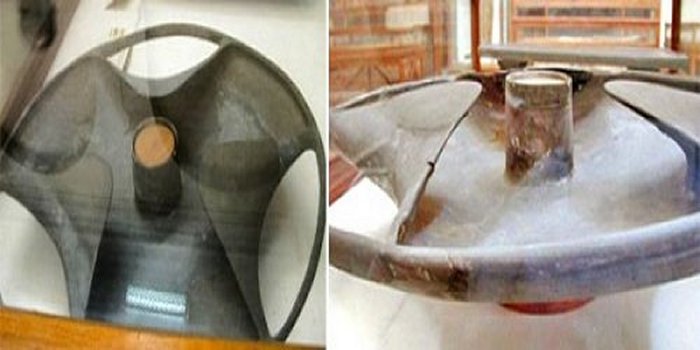Schist Disk – Mysterious Piece Of Sophisticated Technology Could Rewrite History – Scientists Are Not Sure What They Are Dealing With
A. Sutherland - AncientPages.com - Researchers are still not sure what kind of extraordinary object they are dealing with.
This peculiar object created 5,000 years ago appears to be part of a component of an ancient unknown advanced mechanism. In January 1936, a strange disk was unearthed at the plateau edge of North Saqqara, approximately 1.7 km north of Djoser's Step Pyramid in Egypt.
The mysterious prehistoric artifact that many considered a device was made in the Tomb of Prince Sabu ('Mastaba of Sabu' - c. 3100-3000 BC) by a famous British Egyptologist Walter Bryan Emery (1902-1971).
Sabu was the son of Pharaoh Aneddzhiba (fifth ruler of the First Dynasty of ancient Egypt) and a high official or administrator of a town or province possibly called the "Star of the family of Horus."
The burial chamber had no stairway, and its superstructure was completely filled with sand and stone vessels, flint knives, arrows, a few copper tools, and the most interesting schist bowl in fragments.
The Schist Disk's unearthed device is approximately 61 cm in diameter (24 inches), one cm thick, and 10.6 cm (4.2 inches) in the center.
It was manufactured by unknown means from this very fragile and delicate material requiring very tedious carving--the production would confound many craftsmen even today.
Now many important questions arise.
What was the original function of the device?
Scientists do not think the object is a wheel because the wheel appeared in Egypt in 1500 BC, during the 18th Dynasty.
If the Schist Disk is a wheel, it would mean ancient Egyptians possessed knowledge of the wheel about 3000 BC during the time of the first Dynasty! This would require Egyptologists to re-write some history books.
If the Schist Disk is not a wheel nor modeled after the wheel, what is it?
Some scientists suggest that the fragile nature of such an intricately carved stone object significantly limits practical usage and suggests a purely ornamental function, religious or other such ritualistic purposes.
Of course, some believe that this subject served another purpose, just to be able to drive a foot oil lamp.
However, critics of this theory argue that the three-blade ceremonial lamp is hardly possible because of the shape and curvature of its petals, which seems to suggest a function, not just decoration.
Did ancient Egyptians have technology far beyond the current?
One option is even more challenging, namely that we are dealing with some kind of unknown advanced ancient technology. Is it possible ancient Egyptians had technology far beyond the current?
Egyptologist Cyril Aldred concluded that, independently of what the object was used for or what it represented, its design was, without a doubt, a copy of a previous, much older metallic object.
Why did the ancient Egyptians bother to design an object with such a complex structure more than 5,000 years ago?
How could a culture that typically used chisels to shape rock have mastered a technique to work such a delicate material to this extraordinary level?
Why would ancient Egyptians invest the time and skills needed to create this object unless it served a very important, specific purpose?
The Schist Disk's futuristic design continues to baffle all who have seen it. Egyptologists offer several theories trying to explain what the disc was used for, but for the moment, no-one has been able to explain the object's complex structure. Obviously, the Schist Disk is an object that played an important role 5,000 years ago.
Undoubtedly, this peculiar object constitutes one of the most perplexing Egyptian and ancient mysteries, and we are left with several unanswered questions.
The Schist Disk is currently in the Cairo Museum.
Written by – A. Sutherland - AncientPages.com Senior Staff Writer
Updated on August 8, 2021
Copyright © AncientPages.com. All rights reserved. This material may not be published, broadcast, rewritten or redistributed in whole or part without the express written permission of AncientPages.com
More From Ancient Pages
-
 On This Day In History: Fascinating Prague Astronomical Clock Mentioned For The First Time – On Oct 9, 1410
News | Oct 9, 2016
On This Day In History: Fascinating Prague Astronomical Clock Mentioned For The First Time – On Oct 9, 1410
News | Oct 9, 2016 -
 Clan MacGregor: Fearless, Lawless And Persecuted Clan Of The Highlands
Featured Stories | Jul 9, 2018
Clan MacGregor: Fearless, Lawless And Persecuted Clan Of The Highlands
Featured Stories | Jul 9, 2018 -
 Scientists Use Ancient DNA To Explore Early European Adaptation
DNA | Nov 27, 2024
Scientists Use Ancient DNA To Explore Early European Adaptation
DNA | Nov 27, 2024 -
 This Is One Of The Oldest Pieces Of Cloth In The World And It’s Made Of Bast Fibers!
Featured Stories | Aug 26, 2023
This Is One Of The Oldest Pieces Of Cloth In The World And It’s Made Of Bast Fibers!
Featured Stories | Aug 26, 2023 -
 Blame The Neanderthals For Your Lower Back Pain – Scientists Say
Archaeology | Mar 8, 2022
Blame The Neanderthals For Your Lower Back Pain – Scientists Say
Archaeology | Mar 8, 2022 -
 Merneith: Mysterious Queen In The Land Of The Pharaohs Could Be Earliest Attested Female Ruler
Featured Stories | Mar 20, 2018
Merneith: Mysterious Queen In The Land Of The Pharaohs Could Be Earliest Attested Female Ruler
Featured Stories | Mar 20, 2018 -
 Unique Steelyard Discovery Sheds Light On Life At Milecastle 46
Archaeology | Aug 4, 2023
Unique Steelyard Discovery Sheds Light On Life At Milecastle 46
Archaeology | Aug 4, 2023 -
 Ancient Biblical Manuscript M.910 We Are Afraid To Open May Contain A Surprise
Archaeology | Feb 19, 2018
Ancient Biblical Manuscript M.910 We Are Afraid To Open May Contain A Surprise
Archaeology | Feb 19, 2018 -
 10 Ancient Shipwrecks And Several Underwater Artifacts Found Around The Island Of Kasos
Archaeology | Mar 14, 2024
10 Ancient Shipwrecks And Several Underwater Artifacts Found Around The Island Of Kasos
Archaeology | Mar 14, 2024 -
 Baths Of Caracalla: Italian Antique Thermae Complex For Leisure, Gossip, Business And Socialisation
Featured Stories | Dec 4, 2023
Baths Of Caracalla: Italian Antique Thermae Complex For Leisure, Gossip, Business And Socialisation
Featured Stories | Dec 4, 2023 -
 Mystery In Abydos: Carved Rock Chambers Discovered Inside Sacred Mountain
Archaeology | Jul 17, 2020
Mystery In Abydos: Carved Rock Chambers Discovered Inside Sacred Mountain
Archaeology | Jul 17, 2020 -
 Ruins Of A Roman-Era Bath And A Floor Mosaic Discovered In Central Anatolia
Archaeology | Dec 28, 2015
Ruins Of A Roman-Era Bath And A Floor Mosaic Discovered In Central Anatolia
Archaeology | Dec 28, 2015 -
 Largest Collection Of Ancient “Cup-Marked” Rocks Ever Found In Scotland
Civilizations | Nov 23, 2018
Largest Collection Of Ancient “Cup-Marked” Rocks Ever Found In Scotland
Civilizations | Nov 23, 2018 -
 Intact 1,800-Year-Old Roman Sarcophagus With Unexpected Treasures Found In France
Archaeology | Sep 26, 2023
Intact 1,800-Year-Old Roman Sarcophagus With Unexpected Treasures Found In France
Archaeology | Sep 26, 2023 -
 Camazotz: ‘Death Bat’ Vampire God In Ancient Maya Beliefs
Featured Stories | Jun 8, 2017
Camazotz: ‘Death Bat’ Vampire God In Ancient Maya Beliefs
Featured Stories | Jun 8, 2017 -
 10 Fascinating Facts About Pharaohs
Ancient History Facts | Jun 21, 2016
10 Fascinating Facts About Pharaohs
Ancient History Facts | Jun 21, 2016 -
 Unsolved Ancient Mystery: Why Were These Foreign Shoes Hidden In A Temple?
Archaeology | Mar 29, 2014
Unsolved Ancient Mystery: Why Were These Foreign Shoes Hidden In A Temple?
Archaeology | Mar 29, 2014 -
 Discovery Of 1500-Year-Old Celestial Observatory Dated To Sassanian Empire
Archaeology | Mar 16, 2017
Discovery Of 1500-Year-Old Celestial Observatory Dated To Sassanian Empire
Archaeology | Mar 16, 2017 -
 What Can Monument 9 Reveal About The Mysterious Olmec Civilization?
Featured Stories | Jun 30, 2023
What Can Monument 9 Reveal About The Mysterious Olmec Civilization?
Featured Stories | Jun 30, 2023 -
 Controversial Ancient Book Of Veles Remains An Unexplained Mystery
Artifacts | Sep 28, 2015
Controversial Ancient Book Of Veles Remains An Unexplained Mystery
Artifacts | Sep 28, 2015




